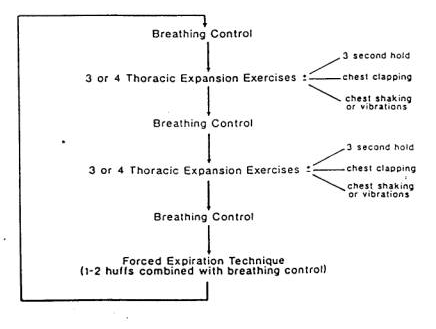Active Cycle of Breathing Technique: Difference between revisions
Aarti Sareen (talk | contribs) No edit summary |
Aarti Sareen (talk | contribs) No edit summary |
||
| Line 56: | Line 56: | ||
== Resources == | == Resources == | ||
[http://www.brit-thoracic.org.uk/ www.brit-thoracic.org.uk]<br> | |||
[http://www.blf.org.uk/Home www.lunguk.org]<br> | |||
== References == | == References == | ||
<references /> | <references /> | ||
Revision as of 21:26, 6 November 2013
Introduction[edit | edit source]
Active Cycle of Breathing (ACBT) is a technique which uses breathing exercises to improves the effectiveness of cough, lossen and clear secreations and improve the ventilation. ACBT have 3 main parts:
- Breathing Control
- Deep Breathing Exercises or thoracic expansion exercises
- Huffing OR Forced expiratory technique (F.E.T)
The FET is an integral part of the Active Cycle of Breathing Technique described by Pryor and Webber in 1992. The authors felt that the FET required expansion because clinically breathing control was underutilized and the link between breathing exercises and FET poorly understood.
BREATHING CONTROL:
Breathing control is used to relax the airways and relieve the symptoms. of wheez and tighness which normally occur after coughing or breathlesness[1]. Breathing should be done by nose gently and if not possible then breathing should be done by mouth.If you breathe out through your mouth you can use breathing control with ‘pursed lips breathing’.It is very important to do Breathing Control in between the more active exercises of ACBT as it allows your airways to relax[2]. Breathing control can also help you when you are short of breath or feeling fearful, anxious or in a panic. The length of time spend doing breathing control will vary depending on how breathless patient feels.
DEEP BREATHING EXERCISES:
Deep breathing is used to get air behind the sputum stuck in small airways[2]
- Relax your upper chest
- Breathe in slowly and deeply
- Breathe out gently until your lungs are empty – don’t force the air out
- Repeat 3 – 4 times, if you feel light headed go back to relaxed breathing.
- At the end of the breath in, hold the air in your lungs for 3 seconds (This is an inspiratory hold).[1]
Deep breathing/Thoracic expansion exercises recruit the collateral ventilatory system assisting, the movement of air distal to mucus plugs in the peripheral airways.[3]
HUFFING/FET:
A huff is exhaling through an open mouth and throat instead of coughing.Huffing moves sputum from the small airways to the larger airways, from where they are removed by coughing[1]. Coughing alone does not remove sputum from small airways.[2]
- Take a medium sized breath in
- Squeeze the breath out by contracting your tummy muscles and keep your mouth and throat open. The breath should be prolonged, but don’t continue until the lungs are empty
- Take a large breath in
- Squeeze the air out as before
- Cough and expectorate any sputum. If you don’t produce any sputum with 1 or 2 coughs, try to stop coughing by using your breathing control
- Allow your breathing to settle with breathing control and then repeat the cycle until your chest feels clear
Small long huffs move sputum from low down into chest whereas big short huffs moves sputum from higher up into chest, so use this huff when it feels ready to come out, but not before.[2]
Indication[edit | edit source]
- Post surgical /pain (rib fracture/ICC)
- Chronic increased sputum production e.g in Chronic bronchitis,cystic fibrosis
- Acute increase sputum production
Procedure[edit | edit source]
ACBT can be performed in sitting, lying or side-lying positions. Initially you should start in a sitting position until you are comfortable and confident to try different ones.Extensive evidence supports its effectiveness in sitting or gravity assisted positions. A minimum of ten minutes in each productive position is recommended. The ACBT may be performed with or without an assistant providing vibration, percussion and shaking. Self percussion/compression may be included by the patient.
Resources[edit | edit source]
References[edit | edit source]
- ↑ 1.0 1.1 1.2 Emma Larner & Penny Galey.THE ACTIVE CYCLE OF BREATHING TECHNIQUE (ACBT).Sept 2002 – review date Sept 2004.
- ↑ 2.0 2.1 2.2 2.3 The Active Cycle of Breathing Techniques.Association of Chartered Physiotherapists in Respiratory Care.Leaflet no.GL-05.Available at http://www.acprc.org.uk/dmdocuments/GL-05%20ACBT.pdf
- ↑ Dentice R.PHYSIOTHERAPY IN RESPIRATORY MEDICINE.Available at http://www.passthefracp.com/Physio%20for%20doctors.htm







